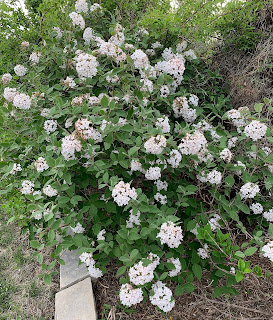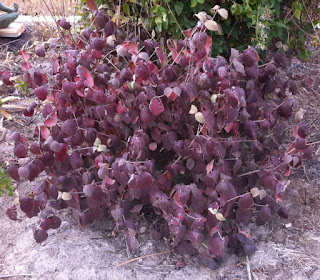 |
| 'Mohawk' Viburnum |
Ask yourself, dear Reader, what is it that trumpets full-blown Spring for you? Do you stir at the first sight of snow crocus? Don your garden clogs at the glimpse of yellow forsythia and blooming redbuds? Rejoice at the sight of cheerful daffodils and deep red tulips? Instead of polls about politicians and social issues, ProfessorRoush would like to see CNN run a poll to determine the jumpoff point of Spring for the gardening public. I might actually care about that result.
I suppose I react to all of the aforementioned signs, but the concept of Spring doesn't really rise up and excite me until the first fragrant viburnums bloom, as they are now beginning to bloom in my garden. When I see those floral white snowballs open, when I suddenly run across a sweet current of air, that's when I really know Spring has arrived. I know it is Spring when my nose tilts to the air and I begin chasing scent across the garden to its source, almost always leading me to a viburnum.
 |
| 'Mohawk' bush form |
'Mohawk' Viburnum has long been one of my favorite shrubs. It exists in my garden in my "peony" bed, next to a wisteria and the path around the southeast corner. 'Mohawk' is a cross of
V. x burkwoodii (itself a cross of
V. utile and
V. carlesii) back to
V. carlesii, and it has the distinction of being released into commerce by The United States Arboretum in 1966. My current 'Mohawk' is about 6 feet tall and 4 feet wide, but I had a previous specimen that reached 8 feet in all directions. When 'Mohawk' is blooming, I can never pass by it without a moment of deep inhalation and intoxication in silent reverence to the fragrance. To imagine Heaven, one must only stand downwind from 'Mohawk', close our eyes, and inhale deeply.
I also grow the Judd Viburnum (
V. juddii, a cross of
V. carlesii and
v. bitchiuense), first introduced around 1920 by William Judd of the Arnold Arboretum, the Burkwood Viburnum "species" plant often seen labeled as
V. burkwoodii (but really a cross of
V. utile and
V. carlesii), and I grow the species
V. carlesii (which is later and not yet in bloom here). All are extremely fragrant, with b
urkwoodii a little larger and more aggressive in my garden than
juddii. The blooms are impossible for me to tell apart without knowing the bush of origin.
 |
| Viburnum burkwoodii |
Of the three viburnums currently in bloom, I prefer the bouquet of 'Mohawk'. It is less sickly sweet than
Juddii or
burkwoodii and it gently bathes my nasal passages in pleasure rather than assaults my schnoz with a wall of overpowering scent. 'Mohawk', to my uneducated nose, has more musky tones, which sound a note of deep calm in the fragrance, and it has a hint of vanilla that appeals to me, vanilla lover that I am.
Juddii is also great, but almost too sweet for me to stand there and inhale long lest I overdose and collapse, and
burkwoodii has some licorice undertones that I'm not as thrilled about as I am about the vanilla of 'Mohawk'.
In this week of yet another hard frost, another strong positive of these viburnums is readily apparent as well. I have not, for a single moment, contemplated them needing any covering or protection because their tough blossoms need none. The waxy petals shrug off frosts and simply resume blooming as soon as the air temperatures catch back up to the calendar. Here, as one gardener suggested to me, on this 83rd day of February in the Kansas Flint Hills.
 ProfessorRoush is not sure what was unique about last winter, but there was a disturbing desertion from the garden this spring, a vexing vacancy of one of my most annually-anticipated arrivals. Sadly, my 'Mohawk' viburnum did not bloom, nay, it did not even bother to leaf out. Normally, this corner is one of my favorite early spots in the garden, but not this year.
ProfessorRoush is not sure what was unique about last winter, but there was a disturbing desertion from the garden this spring, a vexing vacancy of one of my most annually-anticipated arrivals. Sadly, my 'Mohawk' viburnum did not bloom, nay, it did not even bother to leaf out. Normally, this corner is one of my favorite early spots in the garden, but not this year.







